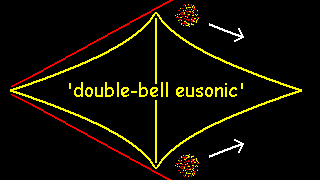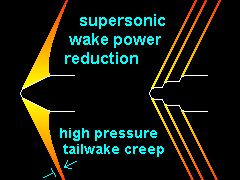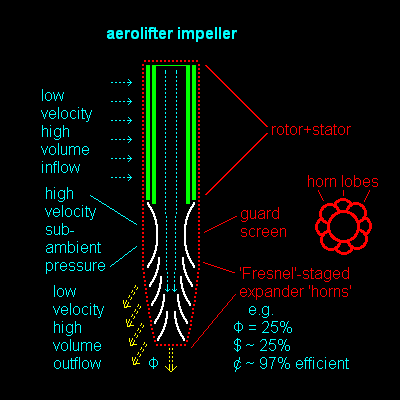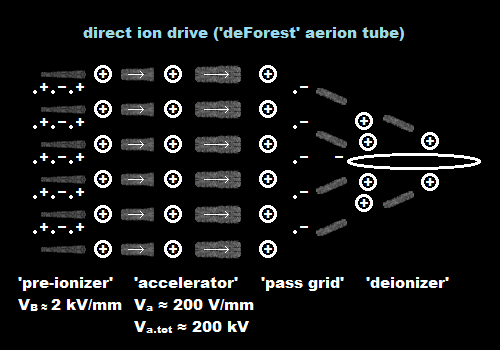
| inducted 'helicopter' ... inducted jet-intake ... inside-out scramjet engine ... super-mach-flow redirector ... |
[topically related to atmosphere shuttle to-from space]
The simple curiosity of winged-flight impels us to reconsider the aerodynamics of wings and jets:
The air flow over a standard wing-section compresses at the leading edge, accelerates over the hump, drawing surrounding air with it, and draws-down with suction aftward pulling the larger air-mass with it (similarly as an 'exponential' audio-speaker-horn transforms high-velocity low mass, to high-mass, low velocity). It is energy-efficient, requiring only a gentle glide slope to maintain velocity.
INDUCTED 'HELICOPTER':
A helicopter down-peller also is winglike, not as fast-moving as the exhaust of a jet engine or the backwash of a plane propeller at takeoff (albeit not by much, as its advantage is mostly the WIG wing-in-ground effect and lower velocity),- and spreading more and moving less, and actually recovering somewhat back up for the blade next-around in flocklike rhythm.
And, near, at, and above, supersonic, airflow is all the more interesting ....

By placing a compact radial-to-centrifugal fan-jet engine air-driver compeller exhausting at top-center over a round expansion section, its outflow sweeps air mass off the broad curved top while sucking a laminar flow hugging around the wing-hunch-like edge and inward behind, drawing-down additional air mass, and providing lift. The air mass collecting underneath the concave base (not diagrammed), slows and increases lift pressure .... 3D expansion below the air-driver is faster-steeper than expansion over a wing-section, and may be more efficient.
Furthermore, By placing an air-heater at the girth while maintaining laminar flow, air drawn back-under is reduced while aft pressure increases yielding upward thrust. The heater can be external nuclear or nuclear-powered electric;- which for the purpose of a shuttle without a nuclear reactor, Be-10, Ca-48, or Zr-96, may be efficient, safe nuclear fuels, fissioning in a controlled-loop beta-chain reaction shielded for moderately high sub-to-mega-voltage (electrons, no neutrons; and the base metal is stable in heated atmosphere).
 For hypersonic, a space-reaching aerolifter, the top is a Mach cone, the base an
aerospike pedestal that generates a birolling air ring maintaining lift and altitude
compensation,- and its vertical profile balanced for subsonic sideways flight;
The air-driver is straighter as a conic ring turbine, which extends upward from flush
position to open as needed at subsonic velocity;- and also condenses air to be
used as propellant in final orbit injection.
(The air-heater may have a heatpumped cooling collar just above.)
For hypersonic, a space-reaching aerolifter, the top is a Mach cone, the base an
aerospike pedestal that generates a birolling air ring maintaining lift and altitude
compensation,- and its vertical profile balanced for subsonic sideways flight;
The air-driver is straighter as a conic ring turbine, which extends upward from flush
position to open as needed at subsonic velocity;- and also condenses air to be
used as propellant in final orbit injection.
(The air-heater may have a heatpumped cooling collar just above.)
(In either engine configuration, the air-driver exhaust air-edge is fluted for better mixing: increased air-air surface, ambience-induction, and turbulence-reduction. The top surface also, may be "golfball"-dimpled to maintain laminar suction;- and the dimples dimpled, etc.)
Comparative theory analysis:
A wing or down-peller takes as much air as possible, without excessive drag, and pushes it down as slowly as possible,- thus imparting maximal pressure moment at minimal energy expenditure .... A common straight-through fan-lifter takes through a narrower aperture, and to get the same pressure moment, draws to lower pressure, accelerates the air more,- and so expels with greatly increased energy imparted .... One improvement would use a columnar intake fan drawing from the sides above .... Another improvement, would use that narrower fan-lifter intake, but draw to even lower pressure the full amount, compress it and extract its heat content to reuse in the engine, and expel the full air full pressure moment at minimimized energy, allowing expansion below .... The aerolifter here utilizes the intake air, on top first. (Another improvement over helicopters uses a full-circumference ring down-peller with multiple fan blades.)
 [Addendum note 2017] Similar and-observational theories have been forwarded in prior centuries,
e.g. the Young-Coanda Effect, and subsequent theories have been attributed thereto that weren't
the originals—for example the originals may have specified a lip-surface that created the vacuum
under the flow-stream, but then ignored the rolling-vortex-pressure and subsequent reconnection
of flow that would've required 'fishskin' shingling or 'golfball' dimpling to restart that vacuum layer;
Also, Coanda Effect devices were limited in travel speed because of self-righting that ignored the
intake-hole-passover-flow that should've needed a secondary, Coanda flange, inner-dome; (also,
surprisingly, ordinary helicopters, haven't been using the Coandă Effect in their tail boom;
and, modern, slatted wing edges appear to be using slow-flow-injection to stabilize laminar, flow.)
[Addendum note 2017] Similar and-observational theories have been forwarded in prior centuries,
e.g. the Young-Coanda Effect, and subsequent theories have been attributed thereto that weren't
the originals—for example the originals may have specified a lip-surface that created the vacuum
under the flow-stream, but then ignored the rolling-vortex-pressure and subsequent reconnection
of flow that would've required 'fishskin' shingling or 'golfball' dimpling to restart that vacuum layer;
Also, Coanda Effect devices were limited in travel speed because of self-righting that ignored the
intake-hole-passover-flow that should've needed a secondary, Coanda flange, inner-dome; (also,
surprisingly, ordinary helicopters, haven't been using the Coandă Effect in their tail boom;
and, modern, slatted wing edges appear to be using slow-flow-injection to stabilize laminar, flow.)
 INDUCTED JET-INTAKE, enhancement:
INDUCTED JET-INTAKE, enhancement:
Low-and high-speed air-intake can be improved by side-suction intake-induction in lieu of forward-only intake: Airflow over a leading 3-D-airfoil hump draws-in more air than inline 'catch-bin' flow, (and, greatly reduces bird-gravel intake);
At supersonic speeds the leading cone becomes a mach-punch slowing the air.
 INSIDE-OUT SCRAMJET [ca 1965]
INSIDE-OUT SCRAMJET [ca 1965]
An early concept utilizing an inverted leading-nozzle 'bell' to slow on-taken air, and
its hypersonic after-shock(wave)wall as its inward-focusing outer pressure-wall to an
'aerospike' nozzle (in-out-reflected-aerospike may need a transsonic capture-deflector
ring at its perimeter).
 SUPERSONIC WAKE REDUCTION - quieter 'boom'
SUPERSONIC WAKE REDUCTION - quieter 'boom'
A first-concept to reduce the sonic 'boom' to multiple steps: Ordinary supersonic
flow piles-up behind the leading edge because the mach zone pressure is higher,
whence the back edge at higher-available-mach-speed creeps into the front edge
at ambient mach-speed, giving it more distinctive temporal compression....
A multiply-stepped mach-punch generates distinct individual shock-fronts that
cannot creep forward: being separated by ambient flow....
 SUPER-MACH-FLOW REDIRECTION - 'drag' reduction
SUPER-MACH-FLOW REDIRECTION - 'drag' reduction
A first-concept 'redirector' for supersonic air from the mach cone, back-around
over the fuselage.... Mach-tines extending back from the hump of the mach-punch
maintain the mach zone behind, where it rebuilds and lets the backside deflect
its backflow and pressure outward-- around, over a mach cavity over the fuselage,
lowering mach flow 'drag' until it reconnects about the rear of the craft.
 COMPACT AIR IMPELLER - vertical lifter
COMPACT AIR IMPELLER - vertical lifter
Semi-vertical downflow maximizes the virtual footprint (sin $) while retaining downflow efficiency (cos ¢), e.g. Φ = 25%, $ ~ 25%, ¢ ~ 97%....
A first-concept compact efficient vertical lifter for single-personal use:
The design is to-- maximize mass flow and momentum while minimizing velocity and
therefore energy use ... the top half has vertical rotors and stators to input
a large volume of air, the lower half has 'Fresnel-lensed' (staged) semi-vertical
exponential-expander air 'horns', to convert high-velocity throughput to low-velocity
higher-ambient pressure large-volume output, with minimal hard footprint....
Also flow-matching lips 'horn-fluting' for better induction and diffusion to ambient....
 AERION DRIVE [2018]
AERION DRIVE [2018]
Additions/suggestions:
[2018-19] AEROSPIKE [new]
...the basic rocket engine, is—a subsonic burner and a mach throat, as singularly large as possible to maximize volume-flow for area-cooling, and then its exhaust is divergently angled off-into-against an enlarging supersonic curve (a properly curved surface) 'outside' or 'inside' even separated by a thermal recovery subsystem or by the entire fuselage width—cf a movie-famous shuttle blended half-closed-half-open-bell-aerocurve-nozzle could use the curvature under its wing-center-(fuselage), for VTOL or at least STOL...
...as what's-wanted, is, ambient pressure (and hence flow) in the center, of a bell, separating only flow-from-flow, pure-efficiency-'weirding' may put the turbines/preburners on the hem-of the bell-nozzle-skirt, (cooler coolant by cooler exhaust), and duct their, coolish-burn-exhaust into (also self-sucking up) the center main-exhaust-flow...
...where the exhaust expands beyond vertical it's losing efficiency that can be extended by also using inducted air
to increase the mass of the exhaust: basically a retaining tube-skirt somewhat below such nozzles...
This article was developed in part for a project Sesquatercet movie-story.